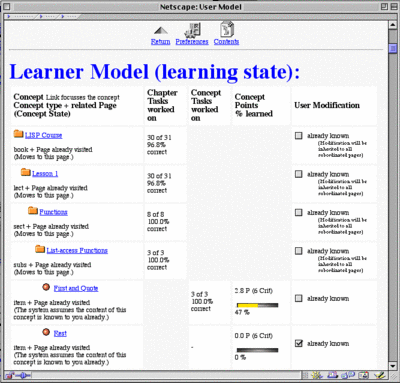Difference between revisions of "Open Learner Modeling"
(→Open Learner Modeling in ELM-ART) |
(→Open Learner Modeling in ELM-ART) |
||
| (2 intermediate revisions by the same user not shown) | |||
| Line 4: | Line 4: | ||
[[ELM-ART]], a combination of a Web-based Electronic Textbook and Intelligent Tutoring System for LISP, was the first Web-Based System to implement open editable learner model. ELM-ART offered a dynamic view, which visualized the current state of learner knowledge about concepts and functions of LISP programming language and allowed learners to correct system's estimation of their knowledge. | [[ELM-ART]], a combination of a Web-based Electronic Textbook and Intelligent Tutoring System for LISP, was the first Web-Based System to implement open editable learner model. ELM-ART offered a dynamic view, which visualized the current state of learner knowledge about concepts and functions of LISP programming language and allowed learners to correct system's estimation of their knowledge. | ||
| − | [[Image:ELM-ART-OLM.gif| | + | [[Image:ELM-ART-OLM.gif|400px|OLM in ELM-ART]] |
== Open Learner Modeling in InterBook == | == Open Learner Modeling in InterBook == | ||
| Line 15: | Line 15: | ||
[[QuizGuide]] is an adaptive front-end to a collection of interactive self-assessment questions in the domain of C programming. The system is able to model learner knowledge independently by topic and visualize the state of this learner model through adaptive link annotation of the “target-arrow” icons. The number of arrows in the target reflects the level of knowledge the student has acquired on the topic: the more arrows the target has, the higher the level of knowledge. The intensity of the target’s color shows the relevance of the topic to the current learning goal: the more intense the color is, the more relevant the topic. This interface combined successful features of open learner models and navigation support: it provides a clear presentation of student knowledge by topic while also helping the student to select the optimal topic to work (one that is ready to be explored, but still not mastered). Check [[QuizGuide]] section to learn more about the systems and the value of this integrated approach. | [[QuizGuide]] is an adaptive front-end to a collection of interactive self-assessment questions in the domain of C programming. The system is able to model learner knowledge independently by topic and visualize the state of this learner model through adaptive link annotation of the “target-arrow” icons. The number of arrows in the target reflects the level of knowledge the student has acquired on the topic: the more arrows the target has, the higher the level of knowledge. The intensity of the target’s color shows the relevance of the topic to the current learning goal: the more intense the color is, the more relevant the topic. This interface combined successful features of open learner models and navigation support: it provides a clear presentation of student knowledge by topic while also helping the student to select the optimal topic to work (one that is ready to be explored, but still not mastered). Check [[QuizGuide]] section to learn more about the systems and the value of this integrated approach. | ||
| − | [[Image:Quizguide.gif|QuizGuide]] | + | [[Image:Quizguide.gif|500px|QuizGuide]] |
== Multi-Layer Zoomable Learner Models == | == Multi-Layer Zoomable Learner Models == | ||
Latest revision as of 20:32, 27 January 2018
Contents
- 1 About Open Learning Modeling
- 2 Open Learner Modeling in ELM-ART
- 3 Open Learner Modeling in InterBook
- 4 Open Learner Modeling with Adaptive Navigation Support in QuizGuide and JavaGuide
- 5 Multi-Layer Zoomable Learner Models
- 6 Open Social Learner Modeling in Progressor, QuizMAP
- 7 Multi-Content Open Social Learner Modeling in Progressor+
- 8 Mastery Grids: Open Source Open Social Learned Modeling Infrastructure
- 9 Rich OLM - Concept-Level OSLM in Mastery Grids
About Open Learning Modeling
Open Learner Modeling in ELM-ART
ELM-ART, a combination of a Web-based Electronic Textbook and Intelligent Tutoring System for LISP, was the first Web-Based System to implement open editable learner model. ELM-ART offered a dynamic view, which visualized the current state of learner knowledge about concepts and functions of LISP programming language and allowed learners to correct system's estimation of their knowledge.
Open Learner Modeling in InterBook
Peter
In our work with QuizGuide and JavaGuide systems we attempted to merge the power of open learner models with the power of adaptive navigation support. While traditional OLM focuses on reflecting student knowledge, we wanted to give students an immediate chance to act. For example, observing that knowledge of a specific topic is too low, a student might want to immediately access learning content that could help to bridge the gap.
QuizGuide is an adaptive front-end to a collection of interactive self-assessment questions in the domain of C programming. The system is able to model learner knowledge independently by topic and visualize the state of this learner model through adaptive link annotation of the “target-arrow” icons. The number of arrows in the target reflects the level of knowledge the student has acquired on the topic: the more arrows the target has, the higher the level of knowledge. The intensity of the target’s color shows the relevance of the topic to the current learning goal: the more intense the color is, the more relevant the topic. This interface combined successful features of open learner models and navigation support: it provides a clear presentation of student knowledge by topic while also helping the student to select the optimal topic to work (one that is ready to be explored, but still not mastered). Check QuizGuide section to learn more about the systems and the value of this integrated approach.
Multi-Layer Zoomable Learner Models
Julio
Open Social Learner Modeling in Progressor, QuizMAP
Sharon
Multi-Content Open Social Learner Modeling in Progressor+
Sharon
Mastery Grids: Open Source Open Social Learned Modeling Infrastructure
Julio
Rich OLM - Concept-Level OSLM in Mastery Grids
Julio


